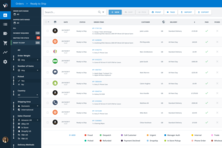Inventory management software for the retail industry focuses on recording the stock levels that a retail company has within an inventory database that updates in real-time.
These solutions streamline order management as they enable businesses to automatically reorder stock that is running low before it runs out, ensuring no sales opportunities are missed. On the other hand, this also means that overstocking can be avoided if certain products aren’t selling as expected.
Common features of retail inventory management software include the ability to organize and filter inventory based on assigned categories (such as by size, style, or color) or departments as well as set up thresholds and alerts for minimum and maximum inventory levels.
Inventory management software aimed at physically-located retail stores can often come equipped or should easily integrate with point-of-sale (POS) capabilities including customer management or sales reporting and analytics. For online-based businesses, however, these solutions can also often feature or integrate with eCommerce functionalities such as customer relationship management (CRM), shopping carts and payment processors, order fulfilment, shipping management, as well as reporting and analytics.

 Veeqo is a fully-fledged inventory management solution that enables retailers to ensure accurate inventory recording across all sales channels, including physical stores, eCommerce websites, and online marketplaces, in real-time.
Veeqo is a fully-fledged inventory management solution that enables retailers to ensure accurate inventory recording across all sales channels, including physical stores, eCommerce websites, and online marketplaces, in real-time.
Retail stores and small businesses use inventory management software as a means to simplify and automate inventory-related tasks. Using cloud-based software where you can access all inventory-related information can make business easier for you. To facilitate this, these products typically feature purchase order management, landed cost allocation, low-stock alerts, multi-location inventory, multi-channel stock sync, transfer orders, bundling, stock takes, and inventory reporting capabilities.
Veeqo, a cloud-based inventory management software solution, is tailored to assist small business owners and retail shops with inventory-related tasks. This is done through easing processes like order management, inventory control, shipping management, warehouse management, product management, scanning and reporting. These software solutions typically operate on a monthly subscription pricing model, making payment and cancellation easier for small and medium businesses.
Before, Excel spreadsheets were the only tool many retail businesses and small companies relied upon. However, with a cultural increase in demand and products, effectively managing wholesale operations while also having to keep track of stock, manage vendors and issue purchase orders at the same time becomes very difficult. To solve issues such as these, retail inventory management software has four main features:
One of the most requested features for retail inventory management software includes basic inventory control. As stated in its name, it deals with controlling the numbers in your inventory. It provides a systematic way for you to track orders, receipts, shrinkage, allocation and shipment of products across the different channels in your enterprise.
When it comes to retail, you need to make sure you have enough to satisfy your customers but not so much that you have an excess of it. There needs to be a certain balance when dealing with the production of goods and services. The basic inventory control calculates this for you while also automatically notifying you of any changes in the inventory. This is also a good alarm against consistent theft over time, from both customers and employees alike.
Stalls in production, supply overstock and pressure from customers can be avoided with the help of barcoding and scanning. Through this feature, processing high volumes of orders can be tracked easier. If there’s a problem with the item from the customer’s side, they can easily send in the barcode to have it replaced by the company immediately.
Due to the large demand, keeping every customer happy with what they’ve purchased can be difficult. It is the utmost duty of retail businesses to keep their consumers happy. However, since each item has a barcode, any questions they have regarding their order, such as the expected date for its arrival, can be tracked and answered fully.
Predicting exactly what your consumers want is near impossible. However, you can forecast what the current market is currently inclined towards and plan what to order next for your production. This feature increases preparedness and productivity as you are able to consider which attributes to drill down on.
It is a series of steps that anticipate the demand for a product and helps make provisions for the finances. The steps include specifying the objective, determining the time perspective, choosing a method for demand forecasting, collecting data and data adjustment, as well as estimating and interpreting results.
In the world of business, analytics help in identifying the best course of action to take. This feature optimizes supply decisions and reduces the risk of excessive inventory and low stocks. It also aims to improve the overall revenue generated by the production.
A lot tracking system records information related to specific raw materials in a particular batch. It gives you the ability to track certain batches of products according to its raw materials, manufacturer, supplier or distributor. By having this feature, pulling out recalled items become easier and eliminates the risk of your retail business is negatively affected.
Before a food product gets shipped off, it has to be regulated by the FDA or Food and Drug Administration. This is important for those selling perishable goods. Instances where a product is called off or recalled still happen from time to time. When it does, the lot tracking feature becomes highly crucial. Lots are defined as specific stock items. For retail businesses, lot tracking makes it easier to pull out those specific products from the market. If the products are being delivered straight to a customer or if a customer has already received them, the company can notify them immediately and ensure their safety.
It is important to keep customers happy with what they’re getting. As the number of companies grows, the competition gets more fierce as well, making an inventory management software solution one of the best assets to have in a retail business.
What this does is it lessens the time and effort spent on menial tasks that eat up a substantial amount of time. In growing businesses, time is part of the investment. Once too much time has been taken by a company to ship items or take in orders, customers quickly lose interest. When customers lose interest, they transfer to people who can give them high-quality items in the shortest time possible.
Inventory management software is one of the best methods to use in ensuring customer satisfaction and loyalty to your business. It helps by implementing core features and functionalities such as basic inventory control, barcoding and scanning, demand forecasting, accounting and lot tracking. These features are designed to keep track of your inventory and avoid running out of stock.
Other benefits you can gain from inventory management software include the ability to process and follow work orders directly in the system, create product variations, identify pieces of inventory through serial numbers, bundle individual items to sell as a package, create special orders to meet individual customer needs, as well as track inventory levels across multiple locations.
Inventory management software solutions have features that seek to improve the overall productivity of your business. To achieve maximum customer satisfaction, retail stores and small organizations must apply the most up-to-date technology to assist in daily tasks while also optimizing for the important ones. Even though these tasks might seem like a chore, they help to keep the business running and, more importantly, growing.